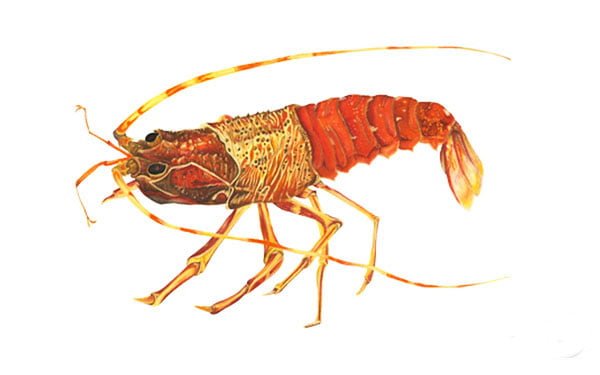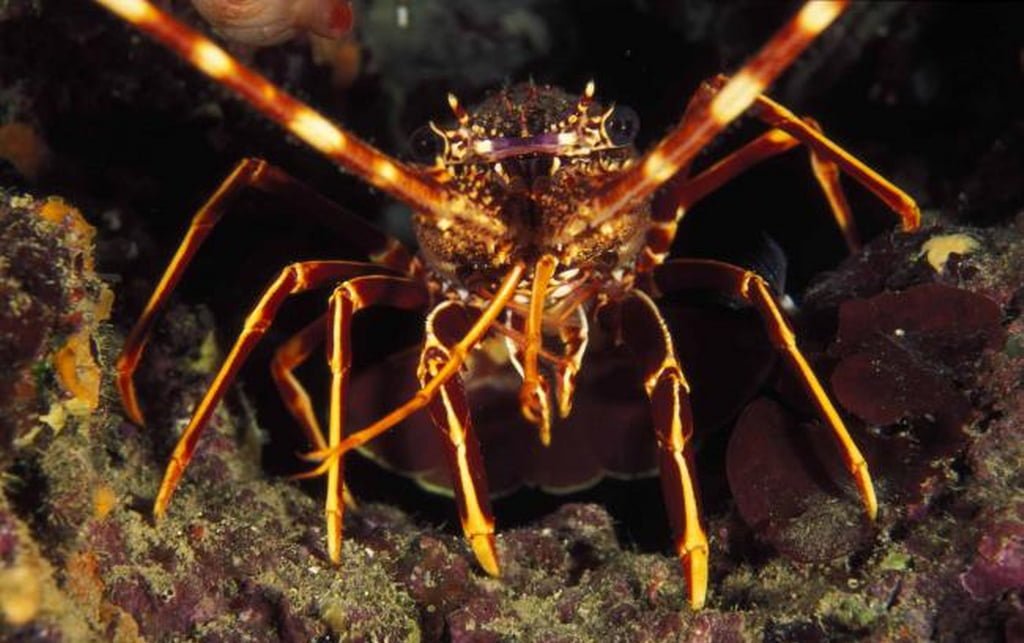Palinurus Elephas
– Mediterranean lobster –


| Kingdom: | Animalia |
| Phylum: | Arthropoda |
| Subphylum: | Crustacea |
| Class: | Malacostraca |
| Order: | Decapoda |
| Family: | Palinuridae |
| Genus: | Palinurus |
| Species: | P. elephas |
| Binomial name |
|---|
| Palinurus elephas (Fabricius, 1787) |
| Synonyms |
| Palinurus vulgaris Latreille, 1803 |


Palinurus elephas is a commonly caught species of spiny lobster from the East Atlantic Ocean and the Mediterranean Sea. Its common names include European spiny lobster,[1] crayfish or cray (in Ireland), common spiny lobster,[2] Mediterranean lobster[3] and red lobster.[4]
Description

P. elephas may reach up to 60 cm (24 in) long,[1] although rarely longer than 40 cm (16 in),[2] and usually 25–30 cm (10–12 in).[6] Few achieve their maximum weight of several kilograms.[5]
The adults are reddish-brown with yellow spots. The carapace is slightly compressed and lacks lateral ridges. It is covered with forward pointing spines, with the supraorbital spines prominent. The antennae are very heavy and spiny. Their flagellum is tapering and is even longer than the body. The first walking leg (pereopod) is provided with subchela (the distal end of a limb developed as a prehensile structure). The fourth segment (merus) of this leg has a characteristic row of spines.[6]
The carapace, which changes several times during growth to recreate a new one. is divided into two parts – the cephalothorax (anterior part) and the abdomen (posterior part) – with a brownish-red to brownish-purple colouration and is strewn with conical-shaped spines. The abdomen is made up of 6 mobile segments, and is equipped with a tiny stinger.
Anteriorly it has two antennae longer than the body, folded backwards, yellow and red at times, which have the function of sensory and defense organs; on the forehead there are also two diverging V-shaped spines.
The last segment of the pleon, the telson, together with the pleopods of the sixth segment, forms the caudal fan, useful for swimming. It has several legs, but only part of it is used for walking.
Being a palinuro , it does not have chelated legs : the lobster is often confused with the lobster which instead has them.
Distribution and Habitat
Palinurus elephas is a common genus species of spiny lobster, found in the eastern Atlantic Ocean, from southern Norway to Morocco and the Azores,[5] and in the Mediterranean Sea, except its eastern extremes.[2] It lives on rocky exposed coasts below the intertidal zone,[1] mainly at depths of 20 to 70 metres (66 to 230 ft). It is named after the ancient Roman Tyrrhenian sea port of Palinurus (modern day Palinuro, Salerno, Italy) where they are found in abundance off its promontory.
Biology
It is a gregarious species, numerous specimens are often found together. Theoretically this crustacean can live indefinitely, given that its DNA does not age, but the effort of changing its carapace and the probable infections it encounters during this phase of its growth are the cause of its death. Specimens over 150 years old have been caught, more than one weighing more than 20 kg.
Alimentation
It feeds in plankton , algae , sponges , annelids , echinoderms , bryozoans , crustaceans , fish and some species of corals, sometimes even carcasses of these.
It is nocturnal and feeds on small worms, crabs or dead animals, hiding in rock crevices or caves during the day.[3]
Reproduction
The breeding season is in September and October, with the female brooding the reddish eggs. These eggs hatch about six months later in the spring as flattened, leaf-shaped, planktonic larvae (phyllosoma larvae).[5][6] immediately reach the depths that will host them for the rest of their life.
Uses
It is a much sought-after delicacy and is widely caught for food around the Mediterranean Sea, mostly with lobster pots, and is also caught less intensively off the Atlantic Coasts of Ireland, Portugal, France and England.[2] There are also small fisheries for this species on the west coast of Scotland, employing tangle nets or lobster pots.
The ‘ Lobster [1] ( Palinurus elephas Fabricius , 1787 ), commonly known as spiny lobster , European spiny lobster , common spiny lobster , is a crustacean of’ order Decapoda who lives in the depths of the Mediterranean Sea and ‘ Atlantic Ocean east.
Threats and Conservation
It is particularly appreciated in the kitchen for the goodness of its meat, however it is a protected species included in Appendix III of the Bern Convention .
In some recipes the method of live cooking in boiling water is applied, as it is widely believed that invertebrates do not perceive pain . In this regard, the Norwegian government had requested a scientific study in 2005 which seemed to have confirmed that their nervous system was unable to process these sensations [2] . However later, in February 2013 a new study by Irish researchers was published which disproved the common opinion and the old Norwegian study, highlighting how the movements of the crustacean at the time of immersion were not due to automatic reflexes, but to real pain perception [3] .
Curiosity
The high content of hemocyanin gives their hemolymph – the common circulation of blood and lymph – the purple color, which however is maintained only when the lobster remains in depth. In the sunlight or on the surface, the purple complexion fades.
Reinhard Förster proposed in 1984 that the Palinuridae may derive from Cancrinos , which was a transitional form between them and the Scyllaridae ( sea cicadas ). [4]
Similar species
In the Mediterranean basin there are two other similar species:
- Palinurus mauritanicus , which is more pink in color and lives at greater depths (180-600m)
- Palinurus regius , which is more green in color
Food allergy
In lobsters, as in many arthropods, the tropomyosin protein is allergenic and can cause food allergy [5] [6] [7] even severe.

















































































































































































































































































































































































